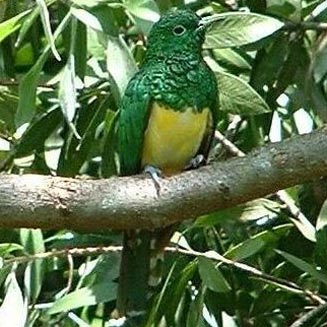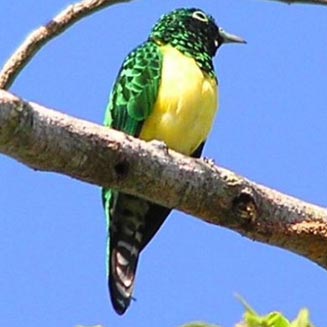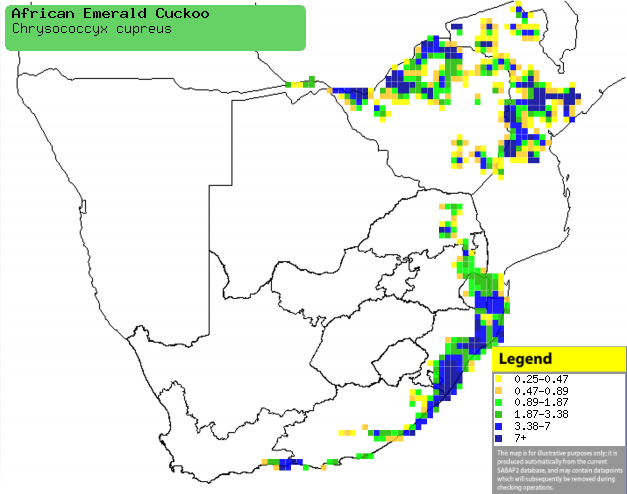|
Chrysococcyx cupreus (African emerald
cuckoo , Emerald cuckoo)
Mooimeisie [Afrikaans]; Intananja [Xhosa];
uBantwanyana [Zulu]; Smaragdkoekoek [Dutch]; Coucou foliotocol [French];
Smaragdkuckuck [German]; Cuco-esmeraldino [Portuguese]
Life
> Eukaryotes >
Opisthokonta
> Metazoa (animals) >
Bilateria >
Deuterostomia > Chordata >
Craniata > Vertebrata (vertebrates) > Gnathostomata (jawed
vertebrates) > Teleostomi (teleost fish) > Osteichthyes (bony fish) > Class:
Sarcopterygii (lobe-finned
fish) > Stegocephalia (terrestrial
vertebrates) > Tetrapoda
(four-legged vertebrates) > Reptiliomorpha > Amniota >
Reptilia (reptiles) >
Romeriida > Diapsida > Archosauromorpha > Archosauria >
Dinosauria
(dinosaurs) > Saurischia > Theropoda (bipedal predatory dinosaurs) >
Coelurosauria > Maniraptora > Aves
(birds) >
Order: Cuculiformes > Family: Cuculidae
 |
 |
|
African emerald cuckoo, Pietermaritzburg, South
Africa. [photo Alan Manson
©] |
African emerald cuckoo, St. Lucia, South Africa.
[photo Jan Van den Broek
©] |
For information about this species, see
www.birdforum.net/opus/African_Emerald_Cuckoo
Distribution and habitat
Occurs across much of sub-Saharan Africa, excluding
extremely arid areas. Within southern Africa it is locally common in the Caprivi
Strip (Namibia). It generally prefers evergreen
and riparian forest, dense woodland and moist savanna, occasionally moving
into well-wooded suburbs.
|
 |
|
Distribution of African emerald cuckoo in southern Africa,
based on statistical smoothing of the records from first SA Bird Atlas
Project (©
Animal Demography unit, University of
Cape Town; smoothing by Birgit Erni and Francesca Little). Colours range
from dark blue (most common) through to yellow (least common).
See here for the latest distribution
from the SABAP2. |
Predators and parasites
Movements and migrations
Primarily a breeding migrant to southern
Africa, staying from September-April, although occasionally remaining in the
remaining in the region during winter.
Food
Mainly eats caterpillars and grasshoppers, supplemented
with adult
Acraea butterflies and fruit such as Wild peach (Kiggeleria africana),
doing most of its foraging in the middle and upper canopy.
Breeding
- Promiscuous, territorial brood parasite, with each male defending a
display territory and mating with multiple females, which then lay their eggs in
the nests of other birds.
- The following birds have been recorded as hosts of the African emerald
cuckoo:
- confirmed in southern Africa
- highly likely to be hosts
- Egg-laying season is from October-January.
- It typically lays a single egg in each host nest (destroying one host
egg first), laying 3-4 egg clutches on successive days; by the end of the
breeding season the female would of laid about 20 eggs in total.
- The chick kicks out any of the host's eggs or nestlings at about two
days old, leaving the nest after approximately 22 days.
Threats
Not threatened, although destruction of riparian and
lowland forest may be cause for concern.
References
-
Hockey PAR, Dean WRJ and Ryan PG 2005. Roberts
- Birds of southern Africa, VIIth ed. The Trustees of the John Voelcker
Bird Book Fund, Cape Town.
|
